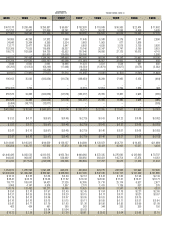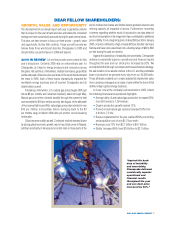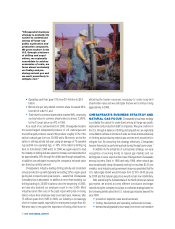Chesapeake Energy 2005 Annual Report Download - page 13
Download and view the complete annual report
Please find page 13 of the 2005 Chesapeake Energy annual report below. You can navigate through the pages in the report by either clicking on the pages listed below, or by using the keyword search tool below to find specific information within the annual report.
total, the company now has more than 3,500 employees, of which
approximately 70% work in the company’s E&P operations and 30%
work in the company’s oilfield service operations. These people are
a highly valued (and much coveted) resource and we are proud they
have chosen Chesapeake as their professional home.
During the past eight years, we have invested more than $3 billion
in new leasehold and 3-D seismic data and now own the largest
inventories in the U.S. of onshore leasehold (8.4 million net acres)
and 3-D seismic data (11.6 million acres). As a result, we believe
Chesapeake has unparalleled opportunities for future value creation.
As to future drilling opportunities, we organize Chesapeake’s
drilling inventory by one of four play types: conventional gas resource,
unconventional gas resource, emerging gas resource and Appalachian
Basin gas resource. The company’s current leasehold and proved
undeveloped and unproved reserve totals by play type are set
forth below:
•2.8 million net acres in our traditional conventional areas (i.e.,
much of the Mid-Continent, Permian, Gulf Coast, South Texas
and other areas) on which we have identified approximately
2,700 drillsites, 1.0 tcfe of proved undeveloped reserves and
approximately 1.0 tcfe of unproved reserves;
•1.1 million net acres in our unconventional gas resource
areas (i.e., Sahara, Granite/Cherokee/Atoka Washes, Hartshorne
CBM, Barnett Shale and Ark-La-Tex tight sands) on which
we have identified approximately 14,000 drillsites, 1.3 tcfe of
proved undeveloped reserves and approximately 4.2 tcfe of
unproved reserves;
•1.2 million net acres in our emerging gas resource areas (i.e.,
Fayetteville Shale, Caney/Woodford Shales, Deep Haley, Deep
Bossier and others) on which we have identified approximately
2,000 drillsites, 0.1 tcfe of proved undeveloped reserves and
approximately 1.9 tcfe of unproved reserves; and
•3.3 million net acres in the Appalachian Basin, where our
play types range from conventional to unconventional to
emerging gas resource. On the significant Appalachian Basin
acreage base acquired from CNR in November 2005, we have
identified approximately 9,200 drillsites, 0.4 tcfe of proved
undeveloped reserves and more than 1.7 tcfe of unproved
reserves.
The company continues to actively acquire more acreage throughout
our operating areas with 1.4 million acres acquired in 2005, of which
almost 500,000 acres were acquired in the 2005 fourth quarter alone
through an aggressive land acquisition program that is currently
utilizing more than 900 contract landmen in the field.
THE COLUMBIA NATURAL RESOURCES
ACQUISITION At the end of the 2005 third quarter, we announced
the largest transaction in the company’s history – the acquisition of
Appalachian natural gas producer Columbia Natural Resources (CNR).
Through this transaction, Chesapeake acquired daily net production
of 125 mmcfe, an extensive 6,500 mile network of natural gas gathering
pipelines, and an internally estimated 3.0 tcfe of proved, probable and
possible reserves, comprised of 1.3 tcfe of proved reserves and 1.7
tcfe of probable and possible reserves. The purchase price was $3
“The company
continues to actively
acquire more acreage
throughout our
operating areas with
1.4 million acres
acquired in 2005, of
which almost 500,000
acres was acquired in
the 2005 fourth quarter
alone through an
aggressive land
acquisition program
that is currently
utilizing more than
900 contract landmen
in the field.”
CHK 2005 ANNUALREPORT 9
























